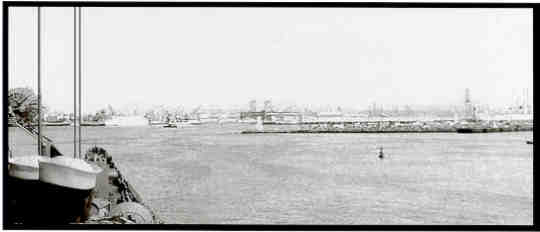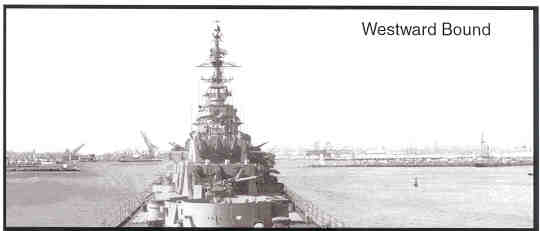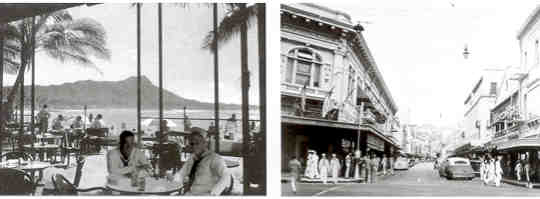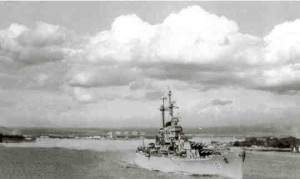 NOVEMBER 1952. During this month, Dwight D. Eisenhower was elected President of the United States with the promise that he would go to Korea to see for himself what the war was all about. During this same month, U. S. S. ROCHESTER departed Long Beach California with a crew that had similar, though less publicized, intentions. Their experiences are chronicled on the pages that follow, with many of the photos being from the ship’s 1952-53 cruise book.
NOVEMBER 1952. During this month, Dwight D. Eisenhower was elected President of the United States with the promise that he would go to Korea to see for himself what the war was all about. During this same month, U. S. S. ROCHESTER departed Long Beach California with a crew that had similar, though less publicized, intentions. Their experiences are chronicled on the pages that follow, with many of the photos being from the ship’s 1952-53 cruise book.
ROCHESTER left Long Beach breakwater in her wake as she headed out into the broad Pacific.
Daily Routine at Sea
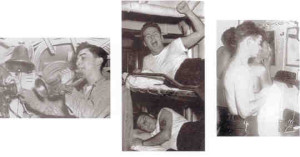 Once underway, the crew settled into an orderly sequence of daily chores.
Once underway, the crew settled into an orderly sequence of daily chores.
Reveille at 0600 hours brought those not on watch out of their bunks to ready themselves for the day ahead.
It took exceptionally large pots to prepare meals for over 1300 sailors.
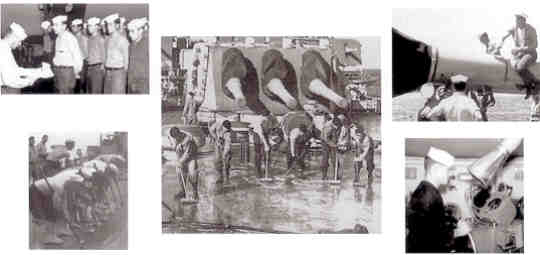 Muster at 0800 ensured that all hands were accounted for. Then followed a day of maintenance, with each Division keeping its space shipshape. Decks were sanded and/or scrubbed, while equipment was kept in working order. Each Division also provided watch standers needed to run the ship, such as the helmsman.
Muster at 0800 ensured that all hands were accounted for. Then followed a day of maintenance, with each Division keeping its space shipshape. Decks were sanded and/or scrubbed, while equipment was kept in working order. Each Division also provided watch standers needed to run the ship, such as the helmsman.
 At workday’s end, those not on watch were free to relax in the ship’s library or view a movie on the mess deck. Then at 2200 hours the Boatswains Mate on watch piped taps and off-watch personnel climbed into their bunks.
At workday’s end, those not on watch were free to relax in the ship’s library or view a movie on the mess deck. Then at 2200 hours the Boatswains Mate on watch piped taps and off-watch personnel climbed into their bunks.
The Islands
The Waikiki of that era was a relaxed setting—very unlike the intense, highly charged Waikiki of today. Sipping a cool tropical drink at the Royal Hawaiian Hotel (left) was an experience that can no longer be recaptured. Many ROCHESTER sailors, however, preferred the more lively establishments on Hotel Street, in downtown Honolulu (right).
 On this day, it seemed these four ROCHESTER sailors (left) had Waikiki Beach to themselves. Meanwhile, four others on the windy Pali had to remove hats that otherwise would have blown away. On the right, there appears to be a sailor in dress whites out on that reef. But that can’t be so. No one would be that crazy!
On this day, it seemed these four ROCHESTER sailors (left) had Waikiki Beach to themselves. Meanwhile, four others on the windy Pali had to remove hats that otherwise would have blown away. On the right, there appears to be a sailor in dress whites out on that reef. But that can’t be so. No one would be that crazy!
After just a few days in the Islands, ROCHESTER steamed out of Pearl Harbor and continued her journey westward.
WestPac
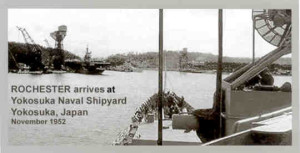
 From the Shipyards main gate, sailors on liberty entered the town of Yokosuka. Usually their first stop was at the Enlisted Men’s Club, a short distance down the street. Most found activities at the EM Club limited, however, so they soon moved on into town.
From the Shipyards main gate, sailors on liberty entered the town of Yokosuka. Usually their first stop was at the Enlisted Men’s Club, a short distance down the street. Most found activities at the EM Club limited, however, so they soon moved on into town.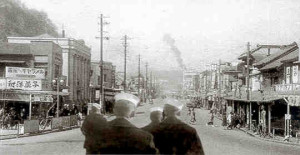
 Options for sailors on liberty in downtown Yokosuka were varied…
Options for sailors on liberty in downtown Yokosuka were varied…
 Well, maybe not really so varied.
Well, maybe not really so varied.
Some establishments catered to simpler tastes (left). And for the more intellectual members of the crew there was even a museum or two in the vicinity.
The War Zone
ROCHESTER remained in port just long enough to be readied for action in Korea, then got underway and steamed south along Japan’s east coast.
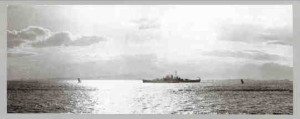 She passed through Shimonoseki Strait between Honshu and Kyushu, then entered the Sea of Japan. Korea lay dead ahead.
She passed through Shimonoseki Strait between Honshu and Kyushu, then entered the Sea of Japan. Korea lay dead ahead.
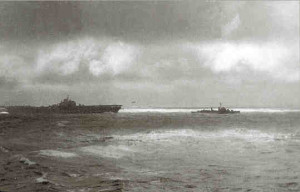 ROCHESTER arrived off the east coast of Korea on 9 December and there joined the fast-carrier force deployed near the “38th Parallel” (38 degrees north latitude). This is where United Nations forces were locked in a stalemate with the Chinese and North Koreans through much of the war.
ROCHESTER arrived off the east coast of Korea on 9 December and there joined the fast-carrier force deployed near the “38th Parallel” (38 degrees north latitude). This is where United Nations forces were locked in a stalemate with the Chinese and North Koreans through much of the war.
The primary mission of the fast-carrier group was to launch air strikes at enemy targets, and ROCHESTER’s main contribution to this effort (aside from her role as escort), was through her helicopter, which was routinely called on to pluck downed aviators from the sea.
 As in her Korean deployment the year before, ROCHESTER alternated between steaming with the carriers and operating independently, or with a destroyer, for firing missions along the coast. In the above photo, she and the destroyer COLLETT are headed north for a raid far behind enemy lines.
As in her Korean deployment the year before, ROCHESTER alternated between steaming with the carriers and operating independently, or with a destroyer, for firing missions along the coast. In the above photo, she and the destroyer COLLETT are headed north for a raid far behind enemy lines.
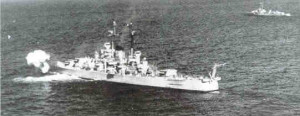 ROCHESTER struck at targets all along the North Korean coast. Railroad junctions, bridges, and supply depots were among targets hammered at Kosong (just north of the 38th Parallel), Wonsan, Hungnam, Songjin and Chongjin (close to the Russian border).
ROCHESTER struck at targets all along the North Korean coast. Railroad junctions, bridges, and supply depots were among targets hammered at Kosong (just north of the 38th Parallel), Wonsan, Hungnam, Songjin and Chongjin (close to the Russian border).
Interlude South
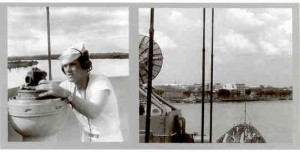 A welcome diversion from the routine of war came late in December, when ROCHESTER was ordered south to Vietnam. She was sent there as a show of support for the beleaguered French, whose attempts to put down the Vietminh were not going well.
A welcome diversion from the routine of war came late in December, when ROCHESTER was ordered south to Vietnam. She was sent there as a show of support for the beleaguered French, whose attempts to put down the Vietminh were not going well.
On the 2nd of January, ROCHESTER navigated up the Saigon River through a region increasingly influenced by the Vietminh. Upon reaching the city, however, she arrived at a place still under tenuous control of the French-backed local government.
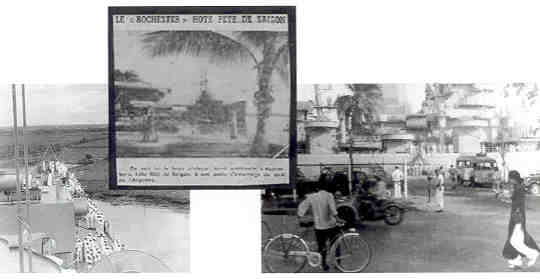 ROCHESTER was the largest warship ever to have steamed that far up the Saigon River. Because the River was too narrow for her to make a normal turn, and as there were no tugs to offer assistance, ROCHESTER ran her bow into the muddy river bank upstream from the city and pivoted around under her own power. She then came alongside Saigon’s wharf headed downstream. From here the liberty party disembarked into a cosmopolitan setting.
ROCHESTER was the largest warship ever to have steamed that far up the Saigon River. Because the River was too narrow for her to make a normal turn, and as there were no tugs to offer assistance, ROCHESTER ran her bow into the muddy river bank upstream from the city and pivoted around under her own power. She then came alongside Saigon’s wharf headed downstream. From here the liberty party disembarked into a cosmopolitan setting.
 Sailors on liberty in Saigon entered a city of sharp contrasts.
Sailors on liberty in Saigon entered a city of sharp contrasts.
The architecture of the stately buildings along downtown streets reflected the regions long history as a French colony, but the city’s outskirts were typical of southeast Asia.

After a few days, ROCHESTER returned down the river and headed back north.
 On 8 January, ROCHESTER called at Manila, in the Philippine Islands. She was there just a few days—enough time for the crew to visit some of the more familiar locations, such as ruins of the old Spanish Fort (right). Then it was time to return to more serious matters farther north.
On 8 January, ROCHESTER called at Manila, in the Philippine Islands. She was there just a few days—enough time for the crew to visit some of the more familiar locations, such as ruins of the old Spanish Fort (right). Then it was time to return to more serious matters farther north.
Upon leaving Manila, ROCHESTER passed between World-War II landmarks Corregidor (below, left) and the Bataan Peninsula.
Back to Business
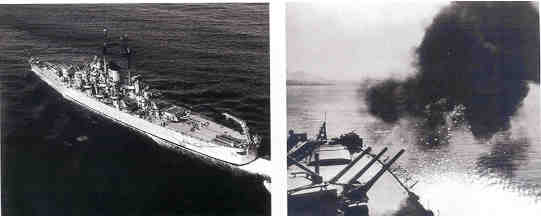 ROCHESTER returned to the war in Korea within a week of leaving the Philippines. Because of Korea’s mountainous interior, most major lines of communication were along the coast and therefore within range of ROCHESTER’s guns.
ROCHESTER returned to the war in Korea within a week of leaving the Philippines. Because of Korea’s mountainous interior, most major lines of communication were along the coast and therefore within range of ROCHESTER’s guns.
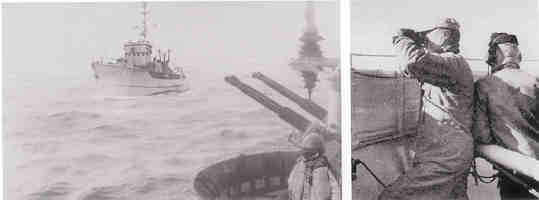 The most serious threats ROCHESTER experienced during operations along the Korean Coast were the thousands of mines set in place by the enemy, particularly in the narrow approach to Wonsan. Minesweepers, like OSPREY (shown above), were the main defense against this threat. These little ships routinely placed themselves in harms way to make passage safe for others. OSPREY was hit three times by fire from enemy shore batteries during her actions in Korea (and five U. S. Navy minesweepers were lost when mines they were attempting to neutralize exploded). She and others like her had hulls of wood, which enabled them to approach mines designed to explode when close to metal, but also made them more vulnerable. Whenever ROCHESTER steamed in these waters, lookouts stationed on the forecastle were alert for mines that may have been missed by the minesweepers.
The most serious threats ROCHESTER experienced during operations along the Korean Coast were the thousands of mines set in place by the enemy, particularly in the narrow approach to Wonsan. Minesweepers, like OSPREY (shown above), were the main defense against this threat. These little ships routinely placed themselves in harms way to make passage safe for others. OSPREY was hit three times by fire from enemy shore batteries during her actions in Korea (and five U. S. Navy minesweepers were lost when mines they were attempting to neutralize exploded). She and others like her had hulls of wood, which enabled them to approach mines designed to explode when close to metal, but also made them more vulnerable. Whenever ROCHESTER steamed in these waters, lookouts stationed on the forecastle were alert for mines that may have been missed by the minesweepers.
 Shore batteries did not fire on ROCHESTER—not even once! Other cruisers—BREMERTON, HELENA, LOS ANGELES, MANCHESTER and SAINT PAUL–as well as the battleships NEW JERSEY and WISCONSIN and 47 destroyers (DD, DDR & DDE), not only were fired on , but also were hit! (HELENA, LOS ANGELES and the destroyer SAMUEL N. MOORE were each hit on two separate occasions – the destroyer MADDOX on three). Perhaps North Korea’s Coastal Defense Command had become aware of the widely recognized accuracy of ROCHESTER’s main battery (see “9 Days On the Firing Line”) and elected to keep their guns concealed when ROCHESTER approached.
Shore batteries did not fire on ROCHESTER—not even once! Other cruisers—BREMERTON, HELENA, LOS ANGELES, MANCHESTER and SAINT PAUL–as well as the battleships NEW JERSEY and WISCONSIN and 47 destroyers (DD, DDR & DDE), not only were fired on , but also were hit! (HELENA, LOS ANGELES and the destroyer SAMUEL N. MOORE were each hit on two separate occasions – the destroyer MADDOX on three). Perhaps North Korea’s Coastal Defense Command had become aware of the widely recognized accuracy of ROCHESTER’s main battery (see “9 Days On the Firing Line”) and elected to keep their guns concealed when ROCHESTER approached.
 With operations continuing for weeks on end, ROCHESTER needed regular replenishment of fuel, ammunition and other supplies—including food and MAIL. The oiler delivering fuel, above left, is British, demonstrating that the war was a United Nations effort. And the “hi-line” operation, upper right, shows that among objects transferred between ships were personnel.
With operations continuing for weeks on end, ROCHESTER needed regular replenishment of fuel, ammunition and other supplies—including food and MAIL. The oiler delivering fuel, above left, is British, demonstrating that the war was a United Nations effort. And the “hi-line” operation, upper right, shows that among objects transferred between ships were personnel.
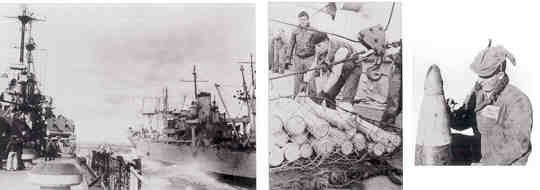 At the rate ROCHESTER was sending projectiles shoreward, there was frequent need for replenishing her store of ammunition. On the right, one of the crew inscribes a message to be delivered to the enemy by the main battery.
At the rate ROCHESTER was sending projectiles shoreward, there was frequent need for replenishing her store of ammunition. On the right, one of the crew inscribes a message to be delivered to the enemy by the main battery.
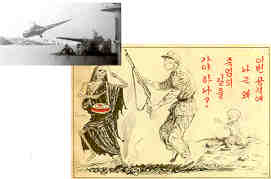 While spotting targets for ROCHESTER’s guns, the helicopter’s crew sometimes took advantage of the opportunity to drop propaganda leaflets on enemy positions.
While spotting targets for ROCHESTER’s guns, the helicopter’s crew sometimes took advantage of the opportunity to drop propaganda leaflets on enemy positions.
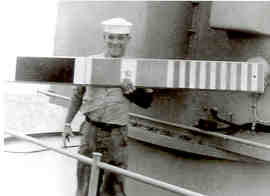 For service in Korea during the winter of 1952-53, ROCHESTER and her crew were awarded one Engagement Star (“Third Korean Winter”) to be placed on their Korean Service Medals. (They earned a total of six Engagement Stars during three tours of war duty between 1950 and 1953.)
For service in Korea during the winter of 1952-53, ROCHESTER and her crew were awarded one Engagement Star (“Third Korean Winter”) to be placed on their Korean Service Medals. (They earned a total of six Engagement Stars during three tours of war duty between 1950 and 1953.)
ROCHESTER alternated periods of 3-4 weeks in the war zone with about a week in Japan. As their tour in WESTPAC entered its final stage, the crew spent more of their time ashore acquiring gifts for the folks and others back home.
Goin’ Home
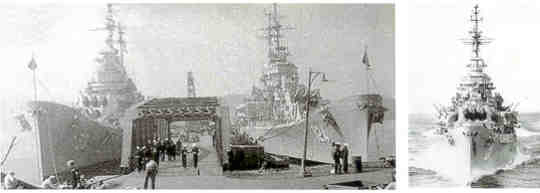 ST. PAUL arrived to relieve ROCHESTER in WESTPAC during mid March, and for a brief time the two cruisers shared a pier at the Yokosuka Naval Shipyard.
ST. PAUL arrived to relieve ROCHESTER in WESTPAC during mid March, and for a brief time the two cruisers shared a pier at the Yokosuka Naval Shipyard.
A little over four months later, it would be ST. PAUL that fired the last shot of the Korean War at sea. That was at 2159 hours on 27 July—one minute before the cease fire went into effect. But on this day in March, ROCHESTER and her crew were happy to leave the closing months of the war behind them and head across the Pacific towards home.
A relaxed mood prevailed as ROCHESTER steamed eastward. A smoker on the after deck helped pass the time for sailors anxious to get home, and even the few days spent during a brief stop at Pearl Harbor were a few too many for most of the crew.
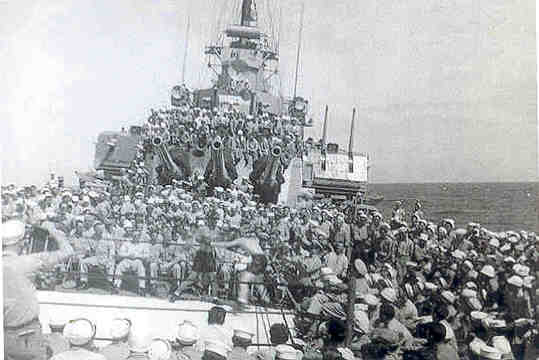
Long Beach California, 6 April 1953
